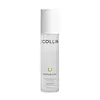What's inside
What's inside
 Key Ingredients
Key Ingredients

No key ingredients
 Benefits
Benefits

 Concerns
Concerns

 Ingredients Side-by-side
Ingredients Side-by-side

Water
Skin ConditioningHamamelis Virginiana Flower Water
AstringentTilia Cordata Flower Water
MaskingRubus Fruticosus Fruit Water
MaskingAloe Barbadensis Leaf Extract
EmollientPropylene Glycol
HumectantSodium Lactate
BufferingSodium PCA
HumectantSorbitol
HumectantProline
Skin ConditioningRosa Centifolia Flower Water
Skin ConditioningPolysorbate 20
EmulsifyingGlycerin
HumectantGlycosaminoglycans
EmollientGlycogen
HumectantButylene Glycol
HumectantPhenoxyethanol
PreservativeMethylparaben
PreservativeEthylparaben
PreservativePropylparaben
PreservativeButylparaben
MaskingAllantoin
Skin ConditioningDiazolidinyl Urea
PreservativeLavandula Spica Flower Oil
MaskingCitrus Limon Peel Oil
MaskingEucalyptus Dives Leaf Oil
PerfumingJuniperus Virginiana Wood Oil
PerfumingLavandula Angustifolia Oil
MaskingCitrus Grandis Peel Oil
MaskingWater, Hamamelis Virginiana Flower Water, Tilia Cordata Flower Water, Rubus Fruticosus Fruit Water, Aloe Barbadensis Leaf Extract, Propylene Glycol, Sodium Lactate, Sodium PCA, Sorbitol, Proline, Rosa Centifolia Flower Water, Polysorbate 20, Glycerin, Glycosaminoglycans, Glycogen, Butylene Glycol, Phenoxyethanol, Methylparaben, Ethylparaben, Propylparaben, Butylparaben, Allantoin, Diazolidinyl Urea, Lavandula Spica Flower Oil, Citrus Limon Peel Oil, Eucalyptus Dives Leaf Oil, Juniperus Virginiana Wood Oil, Lavandula Angustifolia Oil, Citrus Grandis Peel Oil
Water
Skin ConditioningButylene Glycol
HumectantGlycerin
HumectantPropanediol
SolventSorbitol
HumectantCeramide NP
Skin ConditioningCholesterol
EmollientPhytosphingosine
Skin ConditioningLactobacillus Ferment
Skin ConditioningBifida Ferment Filtrate
Skin ConditioningStearic Acid
CleansingCaprylyl Glycol
EmollientOleic Acid
EmollientCaprylic/Capric Triglyceride
MaskingHydrogenated Lecithin
EmulsifyingAllantoin
Skin ConditioningPanthenol
Skin ConditioningLactic Acid
BufferingBetaine
HumectantHydroxyethylcellulose
Emulsion StabilisingHydroxyacetophenone
Antioxidant1,2-Hexanediol
Skin ConditioningCaprylhydroxamic Acid
Water, Butylene Glycol, Glycerin, Propanediol, Sorbitol, Ceramide NP, Cholesterol, Phytosphingosine, Lactobacillus Ferment, Bifida Ferment Filtrate, Stearic Acid, Caprylyl Glycol, Oleic Acid, Caprylic/Capric Triglyceride, Hydrogenated Lecithin, Allantoin, Panthenol, Lactic Acid, Betaine, Hydroxyethylcellulose, Hydroxyacetophenone, 1,2-Hexanediol, Caprylhydroxamic Acid
 Reviews
Reviews

Ingredients Explained
These ingredients are found in both products.
Ingredients higher up in an ingredient list are typically present in a larger amount.
Allantoin is a soothing ingredient known for its protective and moisturizingg properties. Because of this, it is often added to products with strong active ingredients.
Studies show higher concentrations of this ingredient can promote wound healing.
Though it can be derived from the comfrey plant, allantoin is produced synthetically for cosmetic products to ensure purity.
Learn more about AllantoinButylene Glycol (or BG) is used within cosmetic products for a few different reasons:
Overall, Butylene Glycol is a safe and well-rounded ingredient that works well with other ingredients.
Though this ingredient works well with most skin types, some people with sensitive skin may experience a reaction such as allergic rashes, closed comedones, or itchiness.
Learn more about Butylene GlycolGlycerin is already naturally found in your skin. It helps moisturize and protect your skin.
A study from 2016 found glycerin to be more effective as a humectant than AHAs and hyaluronic acid.
As a humectant, it helps the skin stay hydrated by pulling moisture to your skin. The low molecular weight of glycerin allows it to pull moisture into the deeper layers of your skin.
Hydrated skin improves your skin barrier; Your skin barrier helps protect against irritants and bacteria.
Glycerin has also been found to have antimicrobial and antiviral properties. Due to these properties, glycerin is often used in wound and burn treatments.
In cosmetics, glycerin is usually derived from plants such as soybean or palm. However, it can also be sourced from animals, such as tallow or animal fat.
This ingredient is organic, colorless, odorless, and non-toxic.
Glycerin is the name for this ingredient in American English. British English uses Glycerol/Glycerine.
Learn more about GlycerinSorbitol is a sugar alcohol. It is a hydrating and moisturizing agent created from the reduction process of glucose.
Most sorbitol is usually made from potato starch. It is also found in fruits such as apples and pears.
As a humectant, Sorbitol helps draw water to the skin. This helps keep the skin hydrated. Sorbitol also helps create a thicker texture in products. You might find sorbitol in your toothpaste and other gels.
It is a non-irritating ingredient that is great for those with dry skin.
Sorbitol is a prebiotic. It helps promote the growth of healthy bacteria on your skin. The bacteria on your skin form a microbiome. This microbiome helps protect your skin from infection and harmful bacteria.
Learn more about SorbitolWater. It's the most common cosmetic ingredient of all. You'll usually see it at the top of ingredient lists, meaning that it makes up the largest part of the product.
So why is it so popular? Water most often acts as a solvent - this means that it helps dissolve other ingredients into the formulation.
You'll also recognize water as that liquid we all need to stay alive. If you see this, drink a glass of water. Stay hydrated!
Learn more about Water